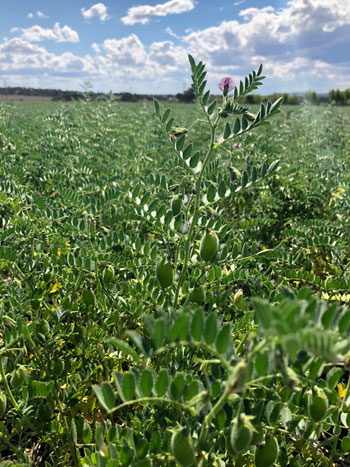Key points
- Sowing chickpeas early can potentially reduce the risk of terminal drought
- The work aims to identify material within the Chickpea Breeding Australia program that can flower, set pods and seed when temperatures are cool
- This would open optimal sowing times within the northern region and allow for more flexibility in sowing dates
By sowing earlier than recommended, researchers are evaluating whether chickpea plants can become reproductive in the cooler winter months.
With the potential to reduce the risk of terminal drought, sowing earlier has benefits – but this needs to be balanced against chickpeas’ sensitivity to cold temperatures.
Leading the work is crop physiologist Dr Neroli Graham from the NSW Department of Primary Industries’ Tamworth Agricultural Institute. During flowering, Dr Graham says, average temperatures below 15°C can cause flower abortion and may result in a delay between flowering and pod onset.
“This can reduce yield potential. Agronomists on the Moree Plains estimated that cool spring conditions in 2016 may have reduced yield potential in the region by 0.5 to 0.7 tonnes per hectare.
“We don’t have a complete picture of this yet, and our project is aiming to better quantify these losses across chickpea growing regions.”
Through time-of-sowing (TOS) trials, Dr Graham’s team aims to identify material within the Chickpea Breeding Australia program that can flower, set pods and seed when temperatures are cool.
“The project’s focus is chilling tolerance – the ability of chickpea lines to flower and set pods/seeds under suboptimal temperatures, below an average of 15°C.
“Finding material that does this would open optimal sowing times within the northern region, allowing for more flexibility in sowing dates.”
Trials
TOS trials commenced in 2018 and have continued through to this year.
In 2018, two trials were conducted at Wagga Wagga and Tamworth, testing two sowing dates. “We chose one earlier than the current optimal sowing window and one in the optimal sowing window at each location,” Dr Graham says.
In 2019, the project conducted six trials, each with a single sowing date, at Kingaroy, Narrabri, Breeza, Wagga Wagga, Leeton and Horsham. Each sowing date was prior to the optimal sowing window for each location.
This year trials have again been held at Wagga Wagga and Tamworth with three sowing dates – one prior to the current optimal sowing window, one in the optimal sowing window and one after the optimal window.
Under normal spring temperatures, Dr Graham says, plants produce flowers that are fertilised and then develop into pods and seeds. “When temperatures are optimal, this process will take several days. When the temperatures are cooler than optimal, the fertilisation and pod development process will take longer or may not occur at all. When the flowers are not fertilised, they will usually fall off a few days after the flower has opened.”

Crop physiologist Dr Neroli Graham from the NSW Department of Primary Industries’ Tamworth Agricultural Institute (left) is leading the work with assistance from technical officer Helene Davidson and research officer Annie Warren. Photo: supplied
The loss of early flowers can cap the crop’s yield potential. “This can be notable when spring is hot, dry and short, and the plants don’t have the ability to compensate later in the season.”
It is important to be able to ‘open up’ the optimal seed-setting window, she says. Doing so would allow the plant to accumulate some seeds during this time and also when temperatures drop below 15°C during the early pod initiation and set.
“Current literature indicates that an average air temperature of 15°C is the base at which flowers develop into seeds. We are aiming to induce flowering and possibly pod-setting in varieties before that average temperature is reached.”
By sowing earlier than recommended, these trials help to identify chickpea lines that have chilling tolerance.
“We are looking for flowers that develop properly and that are fertile. These flowers are then fertilised, with a pod and seed developing, at temperatures below 15°C. It can be difficult to identify and follow this development at suboptimal temperatures as pod and seed growth can be slower when compared to warmer temperatures in spring.”
Findings
Although the research is ongoing, there have been preliminary findings.
 With the potential to reduce the risk of terminal drought, research at the Tamworth Agricultural Institute is assessing the benefits of sowing earlier than usual, but it needs to be balanced against chickpeas’ sensitivity to cold temperatures. Photo: Annie Warren
With the potential to reduce the risk of terminal drought, research at the Tamworth Agricultural Institute is assessing the benefits of sowing earlier than usual, but it needs to be balanced against chickpeas’ sensitivity to cold temperatures. Photo: Annie Warren
For example, the 2018 trials have shown there is variability between location and genotypes, dependant on how lines respond to sowing dates and environmental conditions. “This may be an artefact of the single sowing year. Further trials this year will illuminate if there are consistent trends across years.”
The team has also gained an understanding of certain chickpea genotypes’ flexibility.
“Some chickpea genotypes are more plastic than others when it comes to the sowing window, while still maintaining good yields when sown early. Others do perform well from early sowing,” Dr Graham says.
“TOS trials this year may further show whether some chickpea lines are more flexible in their sowing window and are able to maintain yield potential over a wide sowing window.”
Although some material from the Chickpea Breeding Australia program has been identified and reincorporated back into the breeding program, candidate chilling lines have limitations.
“This means they will not be released by the breeding program. Growers will have to wait until early pod and seed-set is incorporated with good pest and disease resistance and high yield potential.”
More information: Dr Neroli Graham, 0439 367 174, neroli.graham@dpi.nsw.gov.au

























































